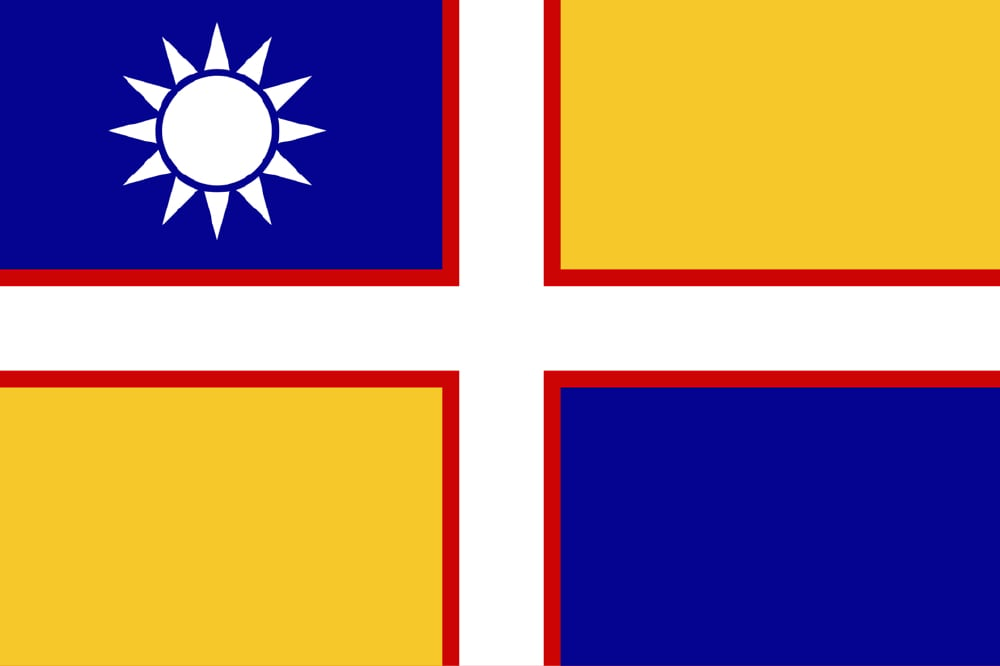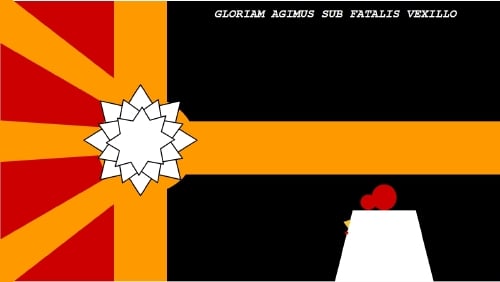| National Factbook |
| Flag: |

|
| Nation Name: |
Melite |
| Leader Name: |
Hristo Tomov |
| Currency: |

Euro |
| National Animal: |

None |
| History: |
Melite’s roots stretch back to the early 12th century, when a wandering eastern prelate, Saint Lysandros, preached a vision of a universal Christian realm amid tribal lands. His miracles—healing springs, turning back invaders—won him followers, and after his death a council of tribal chieftains united in 1124 CE under the Crimson Cross Banner, founding the first Melitian theocratic polity.
Their mythical founding charter, The Covenant of Blood and Grace, declared Melite as God’s chosen nation—a defender of the faith and protector of Christian peoples across broken lands.
Medieval Expansion & Culture
By the 13th century, Melite had grown into a kingdom stretching from coastal forests to high alpine borders. Its ruling dynasty, the House of Lysandros, enforced ecclesiastical law; bishops governed cities and knights swore their oaths both to king and to high priests.
Church and state fused: cathedral‑fortresses dominated cities. Liturgical music, gospel drama, illuminated manuscripts, sacred architecture and relic veneration all flourished. Melitian universities, founded in 1278 in the city of Marielis, became renowned centres of theology, law, and arms production—crafting cross‑shaped shields and war chimes used in ritual parades.
Wars of Faith & Rivalries
The Hundred Sieges Wars (1350–1450) saw Melite defend itself against neighbouring pagani tribes and heretical lords. Crusader‑style military orders, like the Order of the Radiant Lance, led holy campaigns. Victory at the Siege of Mirabar in 1423 CE secured coastal ports and reinforced Melite’s divine mandate.
Meanwhile rival Christian kingdoms claimed competing theological doctrines. A schism in 1499 CE created two denominations: the Puritan Rite, austere and militaristic, and the Glorious Rite, ornate, aligned with the high‑art cathedral tradition. Although both remained within Melite, their political factions often clashed—sometimes erupting in civil war.
Golden Age & Colonial Ambitions
From 1500 to 1650, Melite’s Golden Age, its fleets and armies sailed beyond seas to evangelize distant islands. Missionary knights established Melitian settlements, introducing cathedral‑style fortresses, liturgical festivals, and monolithic crosses carved from native stone.
In that era, a Melitian colonial council governed distant territories—professing a doctrine of both conquest and spiritual salvation. This created both prosperity and resentment: indigenous rebellions tested the empire’s resolve, while Melitian theologians debated whether forced conversion violated divine love.
Decline & Rebirth
By 1750, internal factional conflicts between Ritist nobles, Puritan generals, and colonial lords weakened the realm. A Great Schism War (1760–1770) nearly shattered unity, but a visionary queen, Eleanor Lysandros II, brokered the Concord of Light and Shadow in 1771—reunifying Melite under a reformed constitution that balanced church and crown.
Her reforms introduced a Council of Saints and State—a shared legislative body. Though still deeply Christian in identity, Melite began modernizing, embracing printing, bureaucracy, and limited religious tolerance to preserve national strength.
Modern Era & New Nation
Cut off from old colonial holdings by 1900 ceaseless rebellions and global politics, Melite entered a new phase. In 2025, following economic crisis, democratic reforms and global upheaval, Melite reinvented itself as a republican federation of regional duchies under a Patronage Church Assembly.
Today’s Melite is a newly‑formed nation-state with a giant Christian culture: enormous cathedrals tower across cities, annual pilgrimages unite millions, and its civic calendar is intertwined with Christian holy days. The modern constitution still enshrines faith as national culture, though religious freedom is guaranteed. |
| Geography |
| Continent: |
Europe |
| Land Area: |
6,078.48 sq. km |
| Terrain: |
Melite is a compact but strikingly diverse nation, nestled between low coastal shores and a series of lush inland hills and small mountains. Its landscape is a tapestry of green—rolling meadows, terraced vineyards, and ancient olive groves stretch between monastic towns and cathedral-crowned hilltops. The air carries the scent of pine and salt, blending sea breeze with forest dew.
To the south and west, Melite opens to the sea, where rocky cliffs give way to harbors carved by centuries of seafaring. White-stone coastal towns line the shore, their red-tiled roofs rising behind fortified seawalls built during the Crusader Age. These ports remain vital to the nation’s trade and naval tradition, often blessed by priests before military launches or fishing expeditions.
Inland, the Central Highlands, a modest mountain chain known as the Sanctus Range, rises gently but defiantly. Peaks rarely exceed 2,000 meters, yet are steep enough to divide the land into natural provinces. They are clothed in evergreens and crowned with ancient monasteries, often built directly into the rock. Pilgrimage paths, paved with weathered stone, wind their way through valleys and forests where deer, wild boar, and birds of prey roam freely.
The northern and eastern regions soften into fertile plains and lakeside lowlands, where rivers born in the highlands run through thick groves and golden pastures. This is Melite’s agricultural heartland, feeding cities with wheat, grapes, and honey. The terrain is gentle, but dotted with crumbling watchtowers—remnants of past border wars and faith-driven crusades.
Despite its small size, Melite feels vast and sacred, shaped by both nature and divine intent. Every hill bears a shrine, every forest a legend, every cliff a story of prayer or war. The geography reflects the nation’s soul: defensible yet open, rugged yet beautiful, deeply rooted in Christian symbolism and tradition. |
| Highest Peak: |
Sacraflamma,
268 meters
|
| Lowest Valley: |
,
0 meters
|
| Climate: |
Melite basks under a perpetual sun, its skies clear and golden nearly all year round. The climate is arid to semi-arid, with intense heat dominating every season. Summer is eternal—long, dry, and scorching. Daytime temperatures regularly climb above 38°C (100°F), and even in the coolest months, the mercury rarely dips below 25°C (77°F).
Rain is scarce, falling briefly in short, powerful bursts only a few times a year. When it comes, it often floods dry riverbeds and breathes sudden life into the parched soil before vanishing again. Thunderstorms are rare but dramatic, seen as divine events—many Melitians still interpret them as omens or divine warnings.
The coastal regions are slightly more temperate, thanks to sea winds that offer some relief during the late afternoon. Breezes carry the scent of salt, sun-baked stone, and incense from open-air shrines near the water. However, humidity is high in the ports, and the nights remain warm and thick with heat.
Inland, the Sanctus Range provides little true coolness; even in the higher altitudes, the air is dry and warm. The mountains glow red at dusk under the blazing sun, and pilgrims often travel before dawn to avoid the heat. |
| People & Society |
| Population: |
321,066 people |
| Demonym: |
Melitean |
| Demonym Plural: |
Meliteans |
| Ethnic Groups: |
Caucasian - 99.7%
Asian - 0.3% |
| Languages: |
Maltese - 99.9% |
| Religions: |
Christianity - 98.3%
Others - 1.7% |
| Health |
| Life Expectancy: |
68 years |
| Obesity: |
7.4% |
| Alcohol Users: |
34.9% |
| Tobacco Users: |
78.2% |
| Cannabis Users: |
0% |
| Hard Drug Users: |
0% |
| Economy |
| Description: |
The nation has capitalist economy |
| Average Yearly Income: |
$119.20 |
| Gross Domestic Product (GDP): |
$210,734,598.00 |
| GDP per Capita: |
$656.36 |
| Gross National Income (GNI): |
$61,725,880.00 |
| Industries: |
The biggest industry is tourism |
| Military |
| History: |
The military forces are in a process of establishment |
| Soldiers: |
320 |
| Tanks: |
0 |
| Aircraft: |
0 |
| Ships: |
0 |
| Missiles: |
0 |
| Nuclear Weapons: |
0 |
| Last Updated: 07/30/2025 12:45 am |














